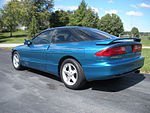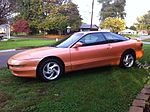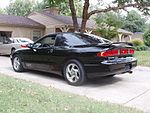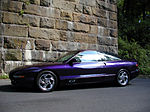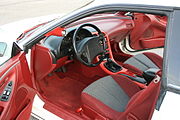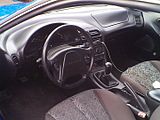Ford Probe
| Ford Probe | |
|---|---|
 | |
| Overview | |
| Manufacturer | Ford |
| Production | 1989–1997 |
| Assembly | Flat Rock, Michigan, U.S. (AAI) |
| Body and chassis | |
| Class | Liftback |
| Layout | FF layout |
| Related | Mazda MX-6 Mazda 626 |
| Chronology | |
| Predecessor | Ford Capri (Europe) Ford EXP (North America) |
| Successor | Ford Cougar (Europe) Ford ZX2 (North America) |
The Ford Probe is a sports liftback produced by Ford, introduced in 1989 to replace the Ford EXP as the company's sport compact car.
The Probe was fully based on the Mazda G-platform using unique sheet metal and interior. The instrument cluster and pop-up headlight mechanisms are borrowed from the FC RX-7.
While it was sold worldwide as a sports coupe, the Probe was intended to fill the market niche formerly occupied by the Capri in Europe, and although it was intended as the replacement to the Ford EXP, it was also considered a possible replacement for the Ford Mustang in the North American market as a direct competitor with the Acura Integra, Nissan 200SX, and the Toyota Celica. During that time, Ford's marketing team had deemed that a front-wheel drive platform (borrowed Mazda GD and GE platforms) would have lower costs for production, and also because the platform had been gaining popularity with consumers.
Mustang fans objected to the front-wheel drive configuration, Japanese engineering, and lack of a V8, so Ford began work on a new design for the Mustang instead. On March 17, 1997, Ford announced the discontinuation of the Probe.[1]
Background
Starting in the late 1970s, Ford and Ghia started exploring a series of futuristic designs with the "Probe" series of concept vehicles.[2] The Probe I, first shown in 1979, was a wedge-shaped design that incorporated a number of drag-reducing features like covered rear wheels and pop-up headlights. This was followed the next year by a much more conventional looking Probe II, whose hatchback styling was also reminiscent of the pony cars. The 1981 Probe III was an advanced demonstrator with covered wheels, but its bodywork evolved into the more conventional Ford Sierra (or Merkur XR4Ti) and styling notes that were used on the Ford Taurus.[3] The 1982 Probe IV was a more radical concept car with a low Cd (drag coefficient), and evolved into the equally radical 1984 Probe V.[4]
After the 1979 energy crisis, the economic slump initiated by high fuel prices prompted Ford to give the Ford Mustang a major redesign. The new design would be based on a totally new platform introduced to Ford by Japanese car manufacturer and Ford partner Mazda. But when the new generation of the Ford Mustang neared its release date, oil prices dropped to an all-time low and Ford Mustang buyers expressed their displeasure in the style of the proposed replacement. The car was eventually released, not as a Ford Mustang but as the Ford Probe.
Ford had previously worked with their Australian division to create and introduce a redesigned Ford Capri, also based on Mazda engineering, and introduced in North America the 1989-1994 Mercury Capri roadster.
The Ford Probe is a product of the joint Ford and Mazda venture called the AutoAlliance International. Its unique body panels and interior were designed and manufactured in the AutoAlliance assembly plant located in Flat Rock, Michigan, the same facility that manufactured the Mazda MX-6 coupe and Mazda 626 sedan for the North American market. Both generations of the Probe were sold in Japan as Fords, at Ford/Mazda sales channels called Autorama. Japanese models were not in compliance with Japanese Government regulations concerning exterior dimensions and engine displacement, resulting in Japanese buyers being held liable for additional taxes as a result.
The Ford Probe was introduced to the U.S. market in 1988 and was completely different from the Mazda MX-6, which was a 2-door liftback with traditional fixed headlights. The Ford Probe shares most of its mechanical parts with the Mazda MX-6 and 626. Both the Ford Probe and the Mazda MX-6 were based on the Mazda GD platform from 1988 to 1992, and on the GE platform from 1993 to 1997.
Initially planned to replace Mustang, Ford executives also expected the Probe to achieve success in the market. However, the car fell short of Ford’s expectations. The Probe's styling, while modern, was not universally accepted. It was also not affordable, making many buyers choose another, more-prestigious brand, for the price of a Ford Probe.
1989–1992 Probe
| First generation | |
|---|---|
 | |
| Overview | |
| Production | 1988–1992 |
| Body and chassis | |
| Body style | 2-door liftback |
| Platform | Mazda GD platform |
| Powertrain | |
| Engine | 2.2 L 110 hp (82 kW) Mazda F2 I4 2.2 L Turbo 145 hp (108 kW) Mazda F2T I4 3.0 L 140 hp (104 kW) Vulcan V6 |
| Transmission | 4-speed Mazda G4A-EL automatic 5-speed manual |
| Dimensions | |
| Wheelbase | 99 in (2,515 mm) |
| Length | 177 in (4,496 mm) |
| Width | 67.9 in (1,725 mm) 1988–1990 GT: 68.5 in (1,740 mm) 1991–92 GT: 68.3 in (1,735 mm) |
| Height | 51.8 in (1,316 mm) 1991–92 LX: 51.9 in (1,318 mm) 1991–92 GT: 52.0 in (1,321 mm) |
The Ford Probe was a Hatchback based on the Mazda GD platform, and powered by a 2.2 L SOHC 4-cylinder Mazda F2 engine. The first generation Probe appeared in 1988 and lasted until 1992 in the United States. It was based on a series of concept cars of the early 1980s, that were seen in films like Judge Dredd, Back to the Future Part II, and Total Recall.
The first generation was available in several trim levels that differ depending on the market in which the vehicle was sold. In the United States, the Probe was available in GL, LX, and GT trim levels:[5]
- The GL was the base model with the 110 hp (82 kW)/130 lb⋅ft (176 N⋅m) F2 2.2 L engine and few options. Most Probes sold in the United States were equipped with air conditioning.
- The LX added options for power locks, power windows, electrically adjusted exterior mirrors, a storage tray underneath the front passenger seat, as well as an optional flip-up moon roof. Starting in 1990, the LX was available with the 3.0 L "Vulcan" V6 engine, that was also used in the Ford Taurus, Ford Ranger, Ford Tempo, and Ford Aerostar. The LX package offered optional equipment, such as a single-disc CD player, and a digital instrument cluster coupled with a fuel economy computer installed in a hidden compartment on top of the center dashboard air conditioning vents.
- The GT included all the equipment of the LX, but featured the F2T 2.2 L turbocharged, intercooled engine that produced 145 hp (108 kW) and 190 lb⋅ft (258 N⋅m) of torque. It came with an IHI RHB5-VJ11 turbocharger and an intercooler to the intake tract, as well as a knock sensor and electronic boost controller to the engine-control system. The boost pressure was 7.3 psi (0.50 bar) in the vicinity of 2,500 rpm. The GT version also came with 4-wheel disc brakes with ABS, a 3-way adjustable suspension utilizing variable damping shocks, and a speed-sensitive variable-assist power steering (VAP). The Probe GT's suspension system was based on a Mazda design, but its tuning was different and included nitrogen-gas pressurized front and rear struts, with stabilizer bars.
The 1991 Probe was given a 4-star crash rating in collision tests conducted by the U.S. National Highway Traffic Safety Administration.[6]
Engine specifications
| Mazda 2.2 L SOHC 12 Valve I4[7] | |
|---|---|
| Type | Inline 4 |
| Displacement | 2.2 L (133 cu in) |
| Compression Ratio | 8.6:1 |
| Engine-control system | Mazda with port fuel injection |
| Power (SAE net) | 110 hp (82 kW) @ 4700 rpm |
| Torque (SAE net) | 130 ft⋅lbf (180 N⋅m) @ 3000 rpm |
| Mazda 2.2 L Turbo SOHC 12 Valve I4 [7] | |
|---|---|
| Type | Inline 4 |
| Displacement | 2.2 L (133 cu in) |
| Compression Ratio | 7.8:1 |
| Engine-control system | Mazda with port fuel injection |
| Power (SAE net) | 145 hp (108 kW) @ 4300 rpm |
| Torque (SAE net) | 190 ft⋅lbf (260 N⋅m) @ 3500 rpm |
| Ford 3.0L Vulcan OHV 12 Valve V6 [7] | |
|---|---|
| Type | V6 |
| Displacement | 3.0 L (182 cu in) |
| Compression Ratio | 9.3:1 |
| Engine-control system | Ford EEC-IV |
| Power (SAE net) | 140 hp (104 kW) @ 4800 rpm (1990) 145 hp (108 kW) @ 4800 rpm (1991-1992) |
| Torque (SAE net) | 160 ft⋅lbf (220 N⋅m) @ 3000 rpm (1990) 165 ft⋅lbf (224 N⋅m) @ 3400 rpm (1991-1992) |
1993–1997 Probe
| Second generation | |
|---|---|
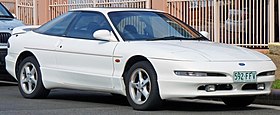 | |
| Overview | |
| Production | 1992–1997 |
| Body and chassis | |
| Body style | 2-door liftback |
| Platform | Mazda GE platform |
| Powertrain | |
| Engine | 2.0 L 118 hp (88 kW) I4 2.5 L 164 hp (122 kW) V6 |
| Transmission | 5-speed G5M manual Optional 4-speed F-4EAT automatic (1993 only, I4 engine) 4-speed CD4E automatic (1994–1997, I4 engine) 4-speed F-4EAT automatic (V6 engine) |
| Dimensions | |
| Wheelbase | 1993–94: 102.9 in (2,614 mm) 1995–97: 102.8 in (2,611 mm) |
| Length | 1993–94: 178.9 in (4,544 mm) 1995–97 Base: 178.7 in (4,539 mm) 1995–97 GT: 179.5 in (4,559 mm) |
| Width | 69.8 in (1,773 mm) |
| Height | 51.6 in (1,311 mm) 1993–94 GT: 51.8 in (1,316 mm) |
| Curb weight | 2,894 lb (1,313 kg) |
The Ford and Mazda design teams merged once again to give the Ford Probe a complete redesign for the 1993 model year. As before, the Probe was to share its under-structure with Mazda's MX-6 and 626. Mazda engineered the engine, transmission, and chassis, while Ford engineered the body and interior. Technically, the second generation Probe is 60% Mazda and 40% Ford. Despite the car being extended 2 inches and widened 4 inches, it was 125 pounds lighter than the first generation Probe. The second generation Probe was introduced in August 1992 as a 1993 model. It went on sale in Europe in the spring of 1994, filling the gap left there by Ford in that market sector since the demise of the Capri seven years earlier.
The base model started at just over US $13,000 and came standard with the 2.0L Mazda FS-DE 16-valve 4-cylinder engine, performance instrument cluster with tachometer and full gauge compliment, and an electronic AM/FM stereo. The sportier GT model started at $15,504[8] and came standard with the 2.5L Mazda K engine KL-DE 24-valve V6, low profile P225/50VR16 91V Goodyear VR50 Gatorback tires, 4-wheel disc brakes, unique front and rear fascias, fog lights, 5-spoke aluminum wheels, leather-wrapped steering wheel, and driver-seat power lumbar/seat back side bolster adjustment. Both engines featured dual overhead cam designs with the choice of a 5-speed manual transmission or a 4-speed automatic transmission.[9]
Two automatic transmissions were available in the Probe. At first both engines shared the same automatic transmission, the Ford F-4EAT transmission, but from 1994 onwards this changed. The V6 engine continued to use the 4EAT, but the 2.0 L I4 engine used a different automatic transmission, the Ford CD4E transmission. It was sourced by Ford, and manufactured at Ford's Batavia Transmission plant in Batavia, Ohio.[10]
A new SE (Sport Edition) trim level was available for 1995 and 1996. It included the GT front fascia (without fog lamps), unique 15-inch (380 mm) aluminum wheels, P205/55R15 BSW and Sport Edition "SE" nomenclature.[11]
In a coast to coast road test by Automobile Magazine in search of the best cars in the world, the Probe GT scored third place, behind an $80,000 Mercedes-Benz and an $80,000 BMW. In the article, the Probe listed at about $15,000.[citation needed]
Special editions
For 1993 and 1994, Ford offered a "SE" appearance package on the base model Probe. The package offered 3 spoke swirl-style alloy wheels, the GT model's ground effects, and the GT model's front bumper. Unlike the base, you were able to opt for power windows and mirrors on the SE package. Appearance wise, the only noticeable differences from the GT model was the wheels, "SE" nomenclature, rear bumper w/o air slot and lack of fog lights. "SE" was an appearance package and not an actual model or trim level. "SE" became a trim level in 1995 and was the middle grade model in the Probe lineup ahead of the base but behind the GT.
In 1994, Ford released a limited edition of the Probe, marketed as the Probe "Feature Car", but officially called the "GT Plus" package. This special package is better known to the general public and enthusiast community as the Probe "Wild Orchid Edition". Included on this limited appearance package was Wild Orchid exterior paint, "PROBE" badge on floor mats outlined in Wild Orchid, black cloth bucket seats with unique Wild Orchid inserts, and the "PROBE" badge on the rear outlined in Wild Orchid. This package was offered in 1994 only, and was exclusive to GT models. After dropping the Probe Feature Car after only a year of production, Ford carried over the Wild Orchid exterior color for the 1995 model year which was available on all Probe models.
In 1997, a "GTS" package was offered on the Probe GT. It was essentially nothing more than an appearance package, as performance was identical to the GT, but differences with the exterior were distinct. Dual racing stripes available in either white or black started at the top edge of the front bumper and continued on to the back lip of the hatch, terminating just below the center light reflector on the rear bumper. A chrome plated version of the GT's directional "swirlie" wheels and a spoiler were also included in the package, as well as having a "blank" center reflector which lacked "GT" lettering as the regular GT models have. The "GTS" was an appearance package and not an actual model or trim level. Very few Probes were produced with the GTS package and are considered today to be extremely rare.
Models/trim levels
- Base • 1993–1995 ; 1997
- SE • 1995–1996
- GT • 1993–1997
In most other markets outside North America, trim levels were labeled as simply 16v (I4) and 24v (V6).
Appearance packages
- SE • 1993–1994
- GT Plus (Wild Orchid Edition) • 1994
- GTS • 1997
Engine specifications
| Mazda 2.0L FS-DE DOHC 16 Valve | |
|---|---|
| Type | Inline 4 |
| Displacement | 2.0 L (121 cu in) |
| Power (SAE net) | 118 hp (88 kW) @ 5500 rpm |
| Torque (SAE net) | 127 ft⋅lbf (172 N⋅m) @ 4500 rpm |
| 0-60 mph | 10.6s[12] |
| 1/4 mile | 16.8 [8] |
| Top speed | 109 mph |
| Mazda 2.5L KL-DE DOHC 24 Valve | |
|---|---|
| Type | 60-degree angle V6 |
| Displacement | 2.5 L (152 cu in) |
| Power (SAE net) | 164 hp (122 kW) @ 5600 rpm |
| Torque (SAE net) | 156 ft⋅lbf (212 N⋅m) @ 4000 rpm |
| 0-60 mph | 7.0s[13] |
| 1/4 mile | 15.5 at 89 mph (142 km/h) [8] |
| Top speed | 137 mph |
Year to year changes
1994
- The 1994 Ford Probe becomes one of the first production cars to have dual air bags as standard equipment
- The dashboard gets a major overhaul. It now used completely different materials, and the right side is redesigned to house a passenger air bag
- Ford introduces the Probe in the European market
- Fog lights are slightly redesigned and now made by a different company
- The stripe on the dashboard is gone, but remains on the interior panels
- The stripe color on Probe GT's door panels are changed from red to the color of the car's interior
- New Ford CD4E automatic transaxle for base and SE models
- Air conditioning units are switched from R-12 to R-134A
- "V6 DOHC 24 VALVE" emblem on engine intake manifold is no longer indented into the manifold and is now raised
- As a cost cutting move, the ability to keep Probe's pop up headlights visible (without the lights being on) is removed
- Fog light button on GT's is slightly redesigned
1995
- Lear Seating Corporation receives Ford's "Most Valued Supplier" award for the manufacturing of the seats in the Probe[citation needed]
- Redesigned tail lights; the 4-cylinder models are outlined in black, the GT's are outlined in red
- SE becomes a trim level/model
- SE model no longer has the GT's ground effects/side skirts
- Distributors are redesigned for better reliability
- New alloy wheels for SE and GT (3 spoke 15" directional for SE, 5 spoke 16" directional "swirlies" for GT)
- Two interior colors are dropped; Red, and blue
- Interior panels no longer have a stripe on them
- Door panels are redesigned and are now a one piece design. GT models get a cloth or leather insert on the door panels.
- Cloth seats are redesigned and are given a unique "spider web" pattern
- GT models get the option of tan/saddle leather interior
- Cup holders are slightly redesigned
- GT models receive red center reflector with 'GT' logo between tail lights. License plate indent moved down onto bumper.
- GT decal on rear bumper replaced with metal '24v' badge
- Rear bumper is redesigned
- Exterior mirrors are redesigned
- Heated exterior mirrors option is dropped
- Graphic equalizer is dropped
1996
- "PROBE" badge stamped on rear windows is gone
- Door ding guards no longer are extended onto the fenders
- Base model dropped; SE is now the standard model
- Probe GT's get the 1995 base/SE's black outlined tails
- Illuminated exterior door locks are dropped
- Tan/saddle color interiors are now available in cloth
- Spoilers are redesigned
- Floor lighting is dropped
- "GT" center reflector above bumper on GT models is now black
- Probe GT gets more refined suspension to improve ride. Ride height is now higher and handling is different as a result.
- Cloth seats are redesigned again and get new fabric
- Probe GT now has spoilers standard
- Rear seats are redesigned
- Probe GT steering wheel's leather is no longer perforated
- New seat belts with automatic locking retractors
- Rear ashtray and map pocket on the passenger door of GT models are dropped
- Rear windshield wiper dropped as an option
- OBD-II compliant
1997
- SE model is dropped ; base model returns and has the GT's front bumper
- Cloth/leather inserts on GT door panels are removed
- Base models get Mazda 626 wheel covers with 15" 3 spoke directional alloys from 95 and 96 Probe SE optional
- Rear windshield wiper returns as an option
- ABS is no longer standard on GT models and is now an option
- GT logos behind the front wheel wells have new letter styling
- Probe GT no longer has "24v" badge beside the "PROBE" badge
- Side door intrusion beams redesigned to meet 1997 Federal Side Impact Standards
- GTS appearance package added to the GT's option list
- Last year for the Probe, with the last Probe being manufactured on June 20, 1997
US production numbers
| Model year | |
|---|---|
| 1993 | 119,754 |
| 1994 | 85,502 |
| 1995 | 52,696 |
| 1996 | 32,505 |
| 1997 | 19,419 |
| Total | 309,876 |
Remaining registered 1993–1997 Probes on the road as of July 2011
| Model year | Base/SE | GT | Combined total |
|---|---|---|---|
| 1993 | 13,294 | 11,001 | 24,294 |
| 1994 | 13,320 | 8,927 | 22,247 |
| 1995 | 12,841 | 5,895 | 18,736 |
| 1996 | 8,428 | 3,732 | 12,160 |
| 1997 | 5,369 | 2,548 | 7,917 |
| Total | 53,252 | 32,102 | 85,354 |
| Difference from 2010 | 9,146 | 4,590 | 13,282 |
.
1999–2002 Cougar
The last Probe came off the assembly line on June 20, 1997. A 3rd generation Probe built on the same platform as the Ford Contour/Mercury Mystique was to be released in mid-1998 as a 1999 model. About 1/3 of the way through designing the 3rd generation Probe, Ford decided to change the name and bring back the Cougar nameplate and badge it as a Mercury.[15] This was done in an unsuccessful attempt to attract younger buyers into Mercury showrooms. As the Probe was born from what was intended to be the new Mustang, the new Cougar was born from what was to be the new Probe. Strangely enough, the Cougar was never considered by Ford to be a successor to the Probe. The Escort ZX2, released shortly after the discontinuation of the Probe, was considered the Probe's successor. In June 1998, Ford released the new Probe as the 1999 Mercury Cougar.
Awards
The Probe GT was Motor Trend magazine's Car of the Year for 1993. It also made Car and Driver magazine's Ten Best list for 1989, 1993, and 1994.
The 1993–1997 Probe was one of the few Fords through the 90's that Consumer Reports recommended.[16]
The NASCAR Dash Series version of a 1990 Ford Probe driven by Jeffrey Collier set a new track record at Daytona International Speedway February 13, 1990 with a speed of 166.553 mph. That record still stands as the fastest closed course lap for a non-turbo 4-cylinder powered car.
Back to the Future II
As Marty McFly arrives in Hill Valley in the year 2015, he encounters two heavily modified 1989 Ford Probes. It is implied that the cars are late models in 2015, as opposed to 26-year-old cars.
See also
External links
- Ford Probe 24v – Information, documents, pictures, about Ford Probe 24v of 1993
References
- ^ "Probe History". Performanceprobe.com. 1997-03-17. Retrieved 2010-06-27.
- ^ History of the Ford PROBE, Concept Cars
- ^ mojo1961 (2010-05-02). "1981 Ford Probe III". Carstyling.ru. Retrieved 2010-07-21.
{{cite web}}: CS1 maint: numeric names: authors list (link) - ^ Sergio (2008-06-10). "1985 Ford Probe V (Ghia)". Carstyling.ru. Retrieved 2010-07-21.
- ^ Geenen, Bernard (1988-03-31). "Ford Probe: La Maztang". Le Moniteur de l'Automobile (in French). 3 (896). Brussels, Belgium: Editions Auto-Magazine: 120.
{{cite journal}}: Unknown parameter|trans_title=ignored (|trans-title=suggested) (help) - ^ "NHTSA". safercar.gov. Retrieved 2008-02-29. [dead link]
- ^ a b c "Ford Probe Specs". performanceprobe.com. Retrieved 2008-02-29.
- ^ a b c Car and Driver, August 1992, Vol.38 No.2, Pages 32-37
- ^ Ford original sales brochure, Litho in Canada 4/92, Pages 20-21
- ^ "ATX Info". atxprobes.com. Retrieved 2008-02-28.
- ^ Ford original sales brochure, Litho in Canada 9/93, Page 14
- ^ "Ford Probe (94-98) – Facts and Figures". parkers.co.uk. Retrieved 2013-09-05.
- ^ "1993 10 Best Cars". caranddriver.com. Retrieved 2013-11-03.
- ^ "Probe production numbers". Probetalk.com. 2001. Retrieved 2016-02-11.
- ^ "3rd gen Ford Probe released as Mercury Cougar". PerformanceProbe.com. 2011-12-13. Retrieved 2011-12-13.
- ^ "Probe awards". bmj9975.rewazule.co. Retrieved 2011-10-10.
- Kevin Smith. "Ford Probe GT". Car and Driver (August 1992): 32–37.

